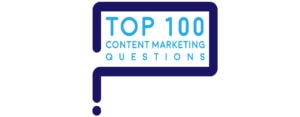
How to anticipate and stay ahead of customers’ content appetite?
How to anticipate and stay ahead of customers’ content appetite
A marketer from Exxon Mobil asked this question in our workshop. It’s one of the Top 100 Questions about content marketing.
The most successful content marketing is customer-centric, not brand-centric. It serves the needs of the audience in order to serve the brand.
Three keys to figuring out which content your audience will go for are:
- Know who your audience is.
- Learn to beat your competitors’ content.
- Keep current with news and trends.
Know who your audience is
You need to define your audience first, so you can figure out what they’re looking for.
Who is your audience, exactly? It probably goes beyond your existing customers or a segment of customers.

Should your audience include prospective buyers such as new people who are entering a certain phase of life or working in a target industry? Do you need to address a bigger audience such as distributors and agents, employees, and communities?
Defining your audience is only the first step.
Next Steps
- Listen to your audience online. What content are they seeking on your website? Which search terms are most used on your website? To get a broader look, use answerthepublic.com and BuzzSumo to find out the questions your audience is asking online.
- Gather and analyze your audience’s direct questions. Work with customer service to find out what questions audience members ask via email, phone calls and chat. Their questions will point to the content they expect from you. Here’s a blog on how to convert buyer questions into compelling content.
- Do buyer persona research – a series of one-on-one interviews that find out what challenges your buyers face, where they go to get information, what kinds of information they seek, what obstacles they find during the buyers’ journey. Here’s a blog on how to do buyer persona research.
Buyers Journey
Now that you’ve listened and done buyer persona research, you can map content to your buyers’ journey. As buyers proceed through a carefully considered purchase, they seek to answer different questions at each of 4 steps:
- Buyers recognize needs. In this first step of the buyers’ journey, they ask, “Do I have a problem? Is it serious? Do I need to change the status quo?”At this stage, buyers tend to prefer short-form content such as blogs and articles, podcasts, e-books, and videos.
- Buyers evaluate a considered set. Next buyers ask, “Which product or service is best? What’s cheaper? What are the trade-offs?”They tend to seek out meatier content such as white papers, webinars, and interactive content. This content fuels their consideration of a set of brands, a long or shortlist they’ll boil down as they find answers.
- Buyers resolve concerns with social proof. Now buyers look to find out what third parties (other than sellers) say. They read reviews, look for ratings, seek product comparisons, read testimonials and case histories. Seeking third-party content reduces the perceived risk of making a final decision about which brand to buy.
- Buyers make a commitment. Buyers choose a brand, sign a contract, and pay or get financing to make the deal. Now is the time to deliver post-sales content to convince the buyer they made a great decision and to help them get on board so they get the most out of their purchase. Induce them to subscribe to ongoing content that fits the needs of users – for example, joining a user community.
Here’s a blog on how to align your content with your buyers’ journey.
Learn to beat your competitors’ content

Before you invest in creating content, check out what buyers can find already – from competitors, from news media, from intermediaries. If you only replicate the content that already exists, it’s not enough to make your brand stand out in the market.
Do a content audit
Look through the eyes of customers at what content is already available. Here’s our blog on how to do a content audit.
Identify the white space in your market. What is it that other content providers don’t offer, or don’t execute as well? Find a space where you can build a content base – content that’s so different and valuable, a customer would be willing to pay for it.

Here’s a blog on how to build your content base.
If you don’t have the resources to build a content base, you can still out-execute other brands by making your content:
- Shorter and easier to understand, compared with others.
- In a format that’s simpler to consume, such as videos, infographics, and podcasts.
- A round-up of all the resources and information about a particular topic, so customers don’t have to hunt around. Instead, they can find everything they need in one place – your website.
Keep current with news and trends
News, trends, and events affect everyone. Use the flow of news and trends to make your content more current and fresher than your competitors’ content.
To do so, work closely with your public relations (PR) team, which keeps its fingers on the pulse of news and events daily. In big companies, PR teams monitor news in real-time, post news clips daily, and follow news sources that marketers may not monitor.

When you monitor the news daily, you can:
- Discover ideas for content that are anchored by an emerging trend
- Find news hooks to freshen your evergreen content.
- Air both sides of a debate about a new issue.
- Use “newsjacking” to ride on competitors’ content. Here’s a blog on how to do newsjacking.
Marketers know, it’s not easy to anticipate and stay ahead of your audience’s content needs. To do so, concentrate on these three steps:
- Know who your audience is.
- Learn to beat your competitors’ content.
- Keep current with news and trends.
“How do you anticipate and stay ahead of customer’s content appetite?” is one of marketers’ Top 100 Questions on content marketing. Here are the answers.






